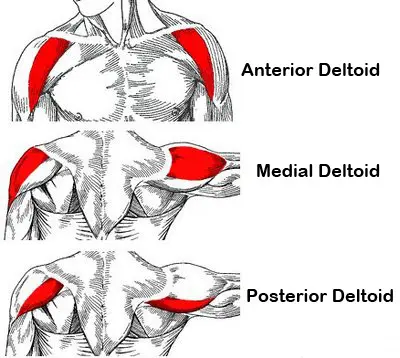While you can build massive shoulders with nothing but overhead presses, if you want to develop better muscle shape, you also need to include lateral raises in your deltoid workouts.
Lateral raises target your medial or side deltoids, which are the muscles that give your shoulders most of their width. Think of the medial deltoids as your natural shoulder pads.
There are several different ways to do lateral raises, including with dumbbells, cables, resistance bands, or a machine, and they’re all effective. However, they all involve keeping your torso upright, which means the movement of each exercise is very similar.
Leaning lateral raises put your torso into a slightly inclined position, changing the angle of your shoulder. While this is a small variation, it can be enough to stimulate new growth in your deltoids.
In this article, we reveal why and how to do this exercise and provide you with a few additional variations and alternatives to try.
Leaning Lateral Raise – Muscles Worked
The leaning lateral raise is an isolation exercise. That means it involves movement at one joint only. As such, it doesn’t work a long list of muscles. The main muscles involved in the leaning lateral raise are:
Level Up Your Fitness: Join our 💪 strong community in Fitness Volt Newsletter. Get daily inspiration, expert-backed workouts, nutrition tips, the latest in strength sports, and the support you need to reach your goals. Subscribe for free!
Medial deltoid
There are three deltoid muscles: anterior (front), posterior (rear), and medial (side). Leaning lateral raises target the medial deltoids. Located on the outside of your shoulder, this deltoid head gives your shoulders their width, contributing to your V-taper.
The primary function of the medial deltoid is abduction of your shoulder joint, meaning to lift your arm up and away from the midline of your body.
Supraspinatus
The supraspinatus is one of the muscles that make up the rotator cuff, which are muscles deep in your shoulders. Supraspinatus is responsible for initiating abduction and is most active between 0 and 15 degrees. While supraspinatus is an important muscle, it’s very small and won’t contribute anything to the size of your shoulders.
Serratus anterior
The serratus anterior is a flat, fan-shaped muscle that wraps around the side of your upper ribs. Its primary function is stabilizing your scapulae or shoulder blades. During leaning lateral raises, the serratus anterior works to keep your scapulae pressed against your ribs.
Trapezius
Known as the traps for short, the trapezius is a large diamond-shaped muscle that covers most of your upper back. It’s made from three sets of fibers: lower, middle, and upper. Each group of fibers has a different function.
The lower fibers depress your shoulders, while the middle fibers pull your shoulders together. However, it’s the upper fibers that are engaged most during leaning lateral raises, and they work to elevate your shoulders. That said, this is a relatively small movement, and leaning lateral raises are probably not the most effective upper trap builder.
How to Do Leaning Lateral Raises
Get more from leaning lateral raises while keeping your risk of injury to a minimum by following these guidelines:
- Hold a dumbbell in your right hand and stand side-on to a sturdy pillar or frame, such as a squat rack.
- Hold the support with your left hand at roughly shoulder height. Your feet should be quite close to the frame.
- Extend your left arm and lean away from the frame, so your body is at an angle.
- Let your right arm hang down from your shoulder, palm facing your leg, and elbow slightly bent.
- Starting each rep from a dead stop, raise your right arm up and out until your dumbbell is roughly level or slightly above your shoulder.
- Smoothly lower your arm back down and repeat, taking care NOT to swing the weight up.
- Repeat for the required number of reps and then switch sides. Do the same number with the opposite arm.
Pro tips:
- Think about leading with your elbow to maximize medial deltoid engagement.
- Raise your pinkie finger slightly at the top of each rep to fully activate the medial deltoid.
- Lower the weight slower than you lift it to recruit more muscle fibers.
- This exercise works best when done for medium to high reps with moderate to light weights, e.g., sets of 12-20.
- Keep your rests between sets short (30-60 seconds) to get a great pump.
Leaning lateral Raise Benefits and Drawbacks
Not sure if leaning lateral raises deserve a place in your shoulder-building workouts? Consider these benefits and then decide!
A unique strength curve
Because of the angle of your torso, leaning lateral raises get harder as you raise your arms. This provides a unique strength curve that really overloads your medial deltoids. If you want to add width to your delts, this exercise should help.
Variation
Even the best exercises lose their potency if you do them too often, and that includes dumbbell lateral raises. Adding leaning lateral raises to your workout will inject your training with some much-needed variety, which could help you stay out of any possible muscle-building ruts.
Joint-friendly
With very little load on your muscles at the start of each rep, the leaning lateral raises may feel more joint-friendly than other lateral raise variations. Therefore, it’s a good option for exercisers who suffer from shoulder pain.
Identify and fix left-to-right strength imbalances
Leaning lateral raises are a unilateral or single-limbed exercise. As such, they make it easier to identify and then correct any left-to-right strength imbalances.
If you notice that one deltoid is stronger than the other, simply train your weak side first and then do the same number of reps with your more powerful arm. Also, consider doing an extra set or two on your weaker side.
In time, you should find your shoulders balance out and become equally well developed.
While leaning lateral raises are a mostly beneficial exercise, there are also a few drawbacks to consider:
Not so good for building strength
Like all isolation exercises, leaning lateral raises do not let you lift heavy weights. So, while this is a good exercise for localized deltoid hypertrophy, it’s less useful for building strength. In other words, this is a bodybuilding exercise rather than a powerlifting exercise. If you want to build shoulder strength, overhead presses are the way to go.
Easy to cheat
Each rep of leaning lateral raises should start with your arm vertical and stationary. However, because of the angle of your torso, there is room for you to start each rep with a swing.
Level Up Your Fitness: Join our 💪 strong community in Fitness Volt Newsletter. Get daily inspiration, expert-backed workouts, nutrition tips, the latest in strength sports, and the support you need to reach your goals. Subscribe for free!
While this would let you use heavier weights or do more reps, it also makes the exercise easier, which could mean it’s less effective. As such, you’ll need to be very disciplined to do this exercise without cheating.
5 Leaning Lateral Raise Variations and Alternatives
Leaning lateral raises are a highly effective shoulder exercise, but that doesn’t mean you need to do them all the time. There are several variations and alternatives you can use to keep your workouts productive and interesting:
1. Leaning cable lateral raise
The main disadvantage with dumbbell leaning lateral raises is there is very little tension on your muscles at the start of each rep. Also, the load increases as you raise your arm. Both of these become non-issues when you do leaning lateral raises with a cable machine.
Leaning cable lateral raises keep your muscles under more constant tension throughout each and every rep, which may mean you get better results.
Steps:
- Attach a D-shaped handle to a low cable machine. Standing side-on to the machine, reach down and grab the handle with your outermost hand.
- Hold the vertical upright of the cable machine with your nearest hand and then extend your arm, so you are leaning away.
- Keeping your upper arm slightly bent but rigid, raise the handle up and out to just above shoulder height.
- Lower your arm back down to your side and repeat.
Muscles targeted:
- Primary: Medial deltoid.
- Secondary: N/A.
Benefits:
- Keeps your muscles under constant tension for a more efficient workout.
- A larger effective range of motion compared to leaning dumbbell lateral raises.
- Ideal for doing muscle-building drop sets.
Tips:
- This exercise works best when done for medium to high reps with moderate to light weights, e.g., sets of 12-20.
- Emphasize each rep’s eccentric or lowering phase to make this exercise even more effective.
- You can do this exercise with the cable in front or behind your legs as preferred.
2. Side-lying lateral raise
Where leaning lateral raises increase the overload on your deltoids at the end of each rep, side-lying lateral raises increase overload at the start. This does not mean they’re better, but they ARE different. Like leaning lateral raises, you can use side-lying lateral raises to add variety to your deltoid-building workouts.
Steps:
- Set the backrest on an adjustable bench to 20-45 degrees.
- Lay sideways on the bench and lean your upper body against the backrest. Hold a dumbbell in your free hand.
- With your elbow slightly bent but rigid, raise your arm up until it’s perpendicular to your body.
- Lower the weight back down and repeat.
- Do the same number of reps on both sides.
Muscles targeted:
- Primary: Medial deltoid, supraspinatus.
- Secondary: N/A.
Benefits:
- A good exercise for adding variety to your deltoid workouts.
- Emphasizes the supraspinatus muscle, which initiates shoulder abduction.
- Keeps constant tension on the medial deltoids for a great pump.
Tips:
- Experiment with different bench angles to see which feels best.
- This exercise works best when done for medium to high reps with moderate to light weights, e.g., sets of 12-20.
- Raise your pinkie finger slightly at the top of each rep to fully activate the medial deltoid.
3. Resistance band lateral raise
Leaning lateral raises increase the overload on your deltoids as you raise your arms away from your sides. You can achieve the same effect with a resistance band. Resistance bands are ideal for home exercisers and traveling lifters with limited gym access. Band training is also very joint-friendly.
Steps:
- Stand on the middle of your band, feet shoulder-width apart. Bend your knees slightly for balance and brace your core.
- Hold the handles with your arms straight and hands by your sides.
- Smoothly raise your arms up and out to the sides until they’re roughly parallel to the floor.
- Lower your arms and repeat.
Muscles targeted:
- Primary: Medial deltoids.
- Secondary: N/A.
Benefits:
- A very accessible exercise that’s ideal for people who train at home.
- Minimal joint stress – a good prehab/rehab shoulder exercise.
- Band exercises are ideal for all levels, especially beginners.
Tips:
- Use a wider stance to put more stretch in your band and make your workout harder.
- Cross the band in front of your legs to increase the tension on your muscles at the start of each rep.
- Pause at the top of each rep to increase time under tension for a more demanding workout.
4. 1 ½ rep lateral raises
You can use the 1 ½ rep technique on many exercises, including squats, bench presses, and deadlifts. However, it works especially well for lateral raises. This training method increases the overload at the top of each rep and will make your deltoids cry for mercy. Be warned, this exercise is more strenuous than it looks, so don’t go too heavy too soon.
Steps:
- Hold a dumbbell in each hand and stand with your arms by your sides, feet shoulder-width apart. Bend your knees slightly for balance and brace your core. Pull your shoulders down and back.
- With a slight bend in your elbows, raise your arms up and out to your side, so they’re parallel to the floor.
- Lower your arms about halfway down and then raise them again.
- Lower your arms all the way back down to your sides and repeat.
Muscles targeted:
- Primary: Medial deltoids.
- Secondary: N/A.
Benefits:
- Get an intense workout using light dumbbells.
- This exercise produces a deep burn and muscle-building pump.
- An excellent finisher for the end of your regular shoulder workout.
Tips:
- Use light dumbbells – this is a very demanding exercise.
- You can also do 1 ½ rep lateral raises using a cable machine or resistance bands.
- Perform high reps with short rests for best results.
5. Victory raise
Are you looking for a truly unique way to challenge your deltoids? One that not only works all three deltoid heads at the same time but that is also good for your joint health? Look no further than the victory raise!
This exercise combines front and lateral raises to provide your shoulders with a great all-around workout that will also improve joint mobility and stability.
Steps:
- Put a resistance band around your wrists and hold a dumbbell in each hand. Start with the weights in front of your hips, palms facing inward.
- Lift the dumbbells forward and up while pushing your arms out to form a V overhead.
- Lower the weights back down, allowing your hands to come back together in front of your hips. Do not relax completely. Instead, keep some tension on the band at the bottom of each rep.
Muscles targeted:
- Primary: Medial, anterior, and posterior deltoids.
- Secondary: Upper, middle, and lower trapezius.
Benefits:
- A very time-efficient shoulder exercise for all three deltoid heads.
- An excellent warm-up or finisher exercise.
- A very unusual exercise that’s ideal for adding variety to your workouts.
Tips:
- Go light; focus on pushing your arms out against the band rather than lifting heavy weights.
- Can be progressed by changing the weight, strength or resistance band, or both.
- Perform this exercise in a tall kneeling position to eliminate your legs and prevent cheating.
- You can also do victory raises without weights, focusing more on pushing your arms outward to emphasize the medial and posterior deltoids.
Leaning Lateral Raise FAQs
Do you have a question about leaning lateral raises or shoulder training in general? Don’t worry – we’ve got the answers!
1. How often should I train my shoulders?
It’s generally accepted that you should hit each major muscle group 2-3 times per week for optimal growth. This provides a good balance between training and recovery. However, it’s worth remembering that your shoulders are also involved in your chest and back workouts, albeit indirectly, so they may not need as much work as your other body parts.
So, start with one shoulder workout per week, and add another if you feel your deltoids need extra attention. Focus mainly on the medial and posterior deltoids, as the anterior or front head gets more than enough work during your chest workout.
2. What is the best rep range for leaning lateral raises?
Leaning lateral raises are an isolation exercise with a long lever. This means a little weight goes a long way, and they’re not really suitable for low-rep, heavy-weight training. As such, you should generally do sets of 12-20 reps of this exercise. However, you can do as many as 30-40 reps per set if you wish, but this will make your workouts longer and less efficient.
But, for your deltoid training to be effective, you MUST take your sets to within a couple of reps of failure. Easy sets do not build muscle!
3. Do I have to do leaning lateral raises to develop bigger deltoids?
While exercises like dumbbell and barbell overhead presses will make your shoulders bigger and stronger, they tend to emphasize your anterior or front deltoids. The medial and posterior delts ARE involved, but they aren’t working as hard as the anterior delts, and are mostly working as stabilizers.
As such, if you want to maximize the size and improve the shape of your shoulders, you probably need to include some isolation exercises in your deltoid workouts, i.e., lateral raises and rear flys.
However, with plenty of similar exercises to choose from, you don’t have to do leaning lateral raises if you don’t want to. But, they are a great exercise and probably deserve a place in your shoulder-building workouts from time to time.
4. Will leaning lateral raises give me wider shoulders?
Yes indeed! Performed correctly, leaning lateral raises directly target your medial or side deltoids, which are the muscles responsible for the width of your shoulders. If you want a broader upper body, you need to include lateral raises in your workouts, and leaning lateral raises are one of the best variations.
5. Are leaning lateral raises safe?
Leaning lateral raises are a pretty safe exercise for most people. The resistance is low at the start of each rep, which means there is less initial inertia to overcome, making them more joint-friendly than some other side-raise exercises.
However, if you use too much weight or your form is wrong, leaning lateral raises could cause aches, pains, or injury, but that’s true of almost every exercise.
Avoid potential problems by using light weights and only increasing the load once you have mastered the exercise. Finally, never sacrifice good form for more weight or reps, as that’s often a fast track to injury.
Wrapping Up
Leaning lateral raises hit your medial or side deltoids from a unique angle. This means they’re a valuable alternative to regular lateral raises. While there is nothing wrong with regular lateral raises, they may become less effective if that’s the only exercise you ever do for your side delts.
Use leaning lateral raises to add some variety to your workouts and keep you out of training ruts. Along with the other exercises mentioned in this article, they’re a very effective way to build broader, more shapely shoulders.
Interested in measuring your progress? Check out our strength standards for Bench Press, Cable Lateral Raise, Deadlift, and more.









